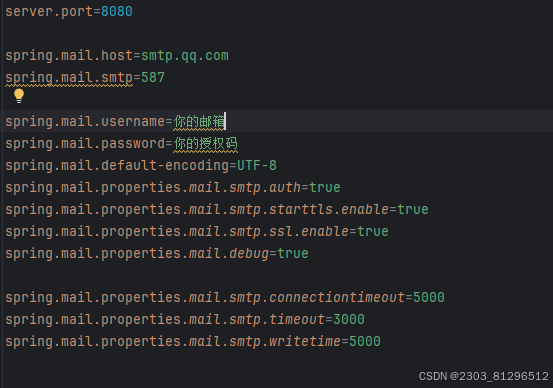⭐引言
Spring Boot 是一个开源的Java框架,旨在简化Spring应用程序的开发过程。它通过提供一系列默认配置,帮助开发者快速搭建项目并专注于业务逻辑,而不是繁琐的配置。本文将深入探讨Spring Boot的核心特性、优点以及实际应用中的最佳实践。
⭐目录
▶️1. Spring Boot的核心特性
1.1 自动配置
Spring Boot的自动配置功能能够根据项目的依赖自动配置Spring应用。开发者只需引入所需的依赖,Spring Boot便会根据上下文自动推断并配置适当的bean。例如,添加spring-boot-starter-data-jpa依赖后,Spring Boot会自动配置数据源和JPA相关的bean。
1.2 起步依赖
Spring Boot提供了一系列“起步依赖”(Starter Dependencies),这些依赖简化了构建和管理项目所需的依赖。例如,spring-boot-starter-web集成了Web开发所需的所有库,如Spring MVC和Tomcat,开发者无需手动添加各个组件。
1.3 嵌入式服务器
Spring Boot支持嵌入式服务器,如Tomcat、Jetty和Undertow。这样,开发者无需外部部署服务器,只需运行应用程序即可启动内嵌的Web服务器,使得开发和测试变得更加高效。
1.4 生产就绪特性
Spring Boot提供了一些用于监控和管理应用的生产就绪特性。比如,Actuator模块可以用来检查应用的健康状况、性能指标以及环境属性等信息,使得运维更加便利。
❄️2. Spring Boot的优点
2.1 简化开发流程
通过自动配置和起步依赖,Spring Boot显著减少了项目初始化和配置的时间。开发者可以更快地构建原型并迭代开发。
2.2 易于测试
Spring Boot鼓励使用JUnit和Spring Test进行单元测试,内置的测试支持使得编写和运行测试变得更加容易。
2.3 社区支持和生态系统
Spring Boot拥有活跃的社区和丰富的文档,开发者可以方便地找到问题的解决方案。此外,Spring Boot与Spring Cloud、Spring Data等生态系统的兼容性,使得开发微服务架构更加便捷。
🍀3. 实际应用中的最佳实践

3.1 使用配置文件管理环境变量
在Spring Boot中,建议使用application.properties或application.yml文件来管理应用配置。这样可以根据不同的环境(如开发、测试、生产)轻松管理配置。
# application.yml
spring:
datasource:
url: jdbc:mysql://localhost:3306/mydb
username: root
password: password
我自己的代码:

3.2 有效利用Actuator
使用Actuator监控和管理应用是最佳实践之一。通过引入spring-boot-starter-actuator依赖,可以快速集成应用监控,确保系统健康。
以下是是依赖环境
<dependency>
<groupId>org.springframework.boot</groupId>
<artifactId>spring-boot-starter-actuator</artifactId>
</dependency>
3.3 编写RESTful API
Spring Boot非常适合构建RESTful API。通过使用@RestController和@RequestMapping注解,开发者可以轻松创建和管理API端点。
@RestController
@RequestMapping("/api")
public class MyController {
@GetMapping("/hello")
public String hello() {
return "Hello, Spring Boot!";
}
}
Spring Boot非常适合构建RESTful API。通过使用@RestController和@RequestMapping注解,开发者可以轻松创建和管理API端点。
@RestController
@RequestMapping("/api")
public class MyController {
private final MyService myService;
@Autowired
public MyController(MyService myService) {
this.myService = myService;
}
@GetMapping("/items")
public List<Item> getItems() {
return myService.getAllItems();
}
@PostMapping("/items")
public ResponseEntity<Item> createItem(@RequestBody Item item) {
Item createdItem = myService.createItem(item);
return new ResponseEntity<>(createdItem, HttpStatus.CREATED);
}
}
⚠️3.4 关注安全性
安全性是任何应用程序的重要组成部分。可以使用spring-boot-starter-security依赖来快速集成安全功能,如用户认证和权限管理。
<dependency>
<groupId>org.springframework.boot</groupId>
<artifactId>spring-boot-starter-security</artifactId>
</dependency>
为了确保应用的安全,使用spring-boot-starter-security依赖,能够快速集成基本的安全功能。以下是如何配置用户认证和授权的示例:
@Configuration
@EnableWebSecurity
public class SecurityConfig extends WebSecurityConfigurerAdapter {
@Override
protected void configure(HttpSecurity http) throws Exception {
http
.authorizeRequests()
.antMatchers("/api/public/**").permitAll() // 公共API
.anyRequest().authenticated() // 其他API需要认证
.and()
.httpBasic(); // 使用基本认证
}
}
4. 讨论最佳实践与反模式
列出常见的最佳实践和反模式,帮助开发者避免常见的陷阱。
5. 引入现代技术栈
讨论如何与现代技术栈结合,比如GraphQL、WebFlux等,展示Spring Boot的灵活性。
6. 参考资料和学习资源
提供一些优质的学习资源和文档链接,帮助读者进一步深入学习。
示例内容提升
自己的程序演示:
package com.lzzy.lzzy.service;
import org.springframework.scheduling.annotation.Async;
import org.springframework.scheduling.annotation.AsyncResult;
import org.springframework.stereotype.Service;
import java.util.concurrent.Future;
@Service
public class MyAsyncService {
@Async
public void sendSMS() throws InterruptedException {
System.out.println("调用短信验证码业务方法");
long startTime = System.currentTimeMillis();
Thread.sleep(5000);
long endTime = System.currentTimeMillis();
System.out.println("短信业务执行完成耗时"+(endTime - startTime));
}
@Async
public Future<Integer> processA() throws InterruptedException {
System.out.println("开始分析并统计业务A数据");
long startTime = System.currentTimeMillis();
Thread.sleep(4000);
int count=123456;
long endTime = System.currentTimeMillis();
System.out.println("业务A数据统计耗时:"+(endTime - startTime));
return new AsyncResult<Integer>(count);
}
@Async
public Future<Integer> processB() throws InterruptedException {
System.out.println("开始分析并统计业务B数据");
long startTime = System.currentTimeMillis();
Thread.sleep(6000);
int count=337321;
long endTime = System.currentTimeMillis();
System.out.println("业务B数据统计耗时:"+(endTime - startTime));
return new AsyncResult<Integer>(count);
}
}
以下是进一步提升后的部分内容示例:
1. 深入技术细节:自动配置原理
Spring Boot的自动配置基于@EnableAutoConfiguration注解,该注解会触发Spring Boot的自动配置机制。自动配置的关键在于spring.factories文件,它定义了各种条件配置类。比如,当类路径中存在特定的库(如Hibernate或Thymeleaf)时,相应的自动配置类就会被加载。
@Configuration
@ConditionalOnClass(DataSource.class)
@EnableConfigurationProperties(DataSourceProperties.class)
public class DataSourceAutoConfiguration {
// 自动配置数据源的逻辑
}
2. 实战项目案例
假设我们要构建一个简单的图书管理系统。首先,我们进行需求分析:
- 用户可以查看图书列表。
- 用户可以添加新图书。
- 管理员可以删除图书。
项目结构:
book-management/
│
├── src/main/java/com/example/bookmanagement
│ ├── controller
│ ├── service
│ ├── model
│ └── repository
│
└── src/main/resources/application.yml
示例代码:
@Entity
public class Book {
@Id
@GeneratedValue(strategy = GenerationType.IDENTITY)
private Long id;
private String title;
private String author;
private String isbn;
}
@RestController
@RequestMapping("/api/books")
public class BookController {
@Autowired
private BookService bookService;
@GetMapping
public List<Book> getAllBooks() {
return bookService.findAll();
}
@PostMapping
public Book addBook(@RequestBody Book book) {
return bookService.save(book);
}
}

3. 性能测试与优化
在开发完成后,使用JMeter对应用进行负载测试,以评估其在高并发情况下的表现。对数据库连接池进行优化,比如调整连接数和超时时间,可以显著提高应用的性能。
结论
Spring Boot作为一个强大且灵活的框架,为开发者提供了构建现代Java应用的工具和支持。通过掌握其核心特性和最佳实践,开发者可以更高效地开发、测试和维护应用程序。在未来,Spring Boot将继续引领Java开发的潮流,推动企业应用的创新与发展。

通过这些改进,文章不仅会更加详细,还能更好地满足不同读者的需求。你觉得这些方向如何?如果有特定的领域想深入探讨,也可以告诉我!

























 14
14

 被折叠的 条评论
为什么被折叠?
被折叠的 条评论
为什么被折叠?








